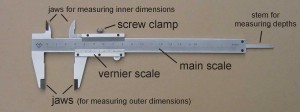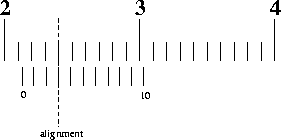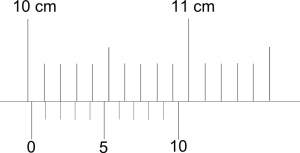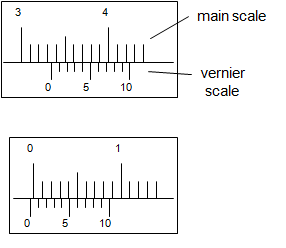How to Read a Vernier Scale Microscope

A quick guide on how to read a vernier caliper. A vernier caliper outputs measurement readings in centimetres (cm) and it is precise up to 2 decimal places (E.thousand. one.23 cm).
Note: The measurement-reading technique described in this post will be similar for vernier calipers which output measurement readings in inches.
Measurement Reading Technique For Vernier Caliper
In lodge to read the measurement readings from vernier caliper properly, y'all need to remember ii things before we start. For example, if a vernier caliper output a measurement reading of 2.13 cm, this means that:
- The main calibration contributes the chief number(s) and one decimal place to the reading (Due east.g. ii.one cm, whereby ii is the master number and 0.1 is the one decimal identify number)
- The vernier calibration contributes the second decimal place to the reading (E.g. 0.03 cm)

Let's examine the image of the vernier caliper readings above. Nosotros will just use a 2 steps method to become the measurement reading from this:
- To obtain the primary scale reading: Look at the prototype in a higher place, 2.ane cm is to the immediate left of the zero on the vernier scale. Hence, the main scale reading is 2.i cm
- To obtain the vernier scale reading: Wait at the prototype above and look closely for an alignment of the scale lines of the main scale and vernier scale. In the image above, the aligned line correspond to iii. Hence, the vernier scale reading is 0.03 cm.
In club to obtain the final measurement reading, we will add together the main scale reading and vernier calibration reading together. This will give 2.1 cm + 0.03 cm = 2.13 cm.
In a nutshell
Use the following formula:
$$ \text{Obtained reading} = \text{Primary scale reading} \, + \, \text{Vernier scale reading} $$
Allow's go through some other case to ensure that you sympathize the above steps:

Master scale reading: 10.0 cm (Firsthand left of zero)
Vernier scale reading: 0.02 cm (Alignment of scale lines)
Measurement reading: 10.02 cm
Compensating For Null Error
In a nutshell
Apply the following formula:
$ \text{Correct reading} = \text{Obtained reading} \, – \, \text{Naught error} $
where $\text{aught error}$ can be either negative (the "0" of vernier scale is left of the "0" of the main scale) or positive (the "0" of vernier calibration is correct of the "0" of the main scale)
Explanation
At present, we shall try with zero error. If you are not familiar on how to handle zero error for vernier calipers, I advise that you lot read up on Measurement of Length.

The reading on the top is the measurement obtained and the reading at the lesser is the zilch error. Find the actual measurement. (Meaning: become rid of the zero error in the measurement or have into account the zilch error)
Measurement with zero mistake: iii.34 cm
Zero mistake: – 0.04 cm (negative because the vernier scale is to the left)
Measurement without cipher error: $3.34 \, – ( \, – 0.04) = 3.38$ cm
If yous exercise not understand the subtraction of the negative zero error from the measurement, please read on. Since the zero error is -0.04 cm, this ways that all measurements taken by the vernier calipers will be SMALLER by 0.04cm. Hence, you will have to ADD 0.04 cm to ALL measurements in order to get the TRUE measurement. The subtraction is done in the above case is to have an elegant way of obtaining a resultant addition: $3.34 + 0.04 = 3.38$ and to make it Compatible with positive zero fault. This means that one time you lot have determined the nature of the zero fault (positive or negative), you can just decrease the nada error and be sure that your last answer is correct.
Consider a nil error of +0.04 cm. With my method, $3.34 \, – (+ 0.04) = 3.xxx$ cm.
Normal method: Since the goose egg error is +0.04 cm, this means that all measurements taken by the vernier calipers will be larger by 0.04 cm. Hence, you volition accept to SUBTRACT 0.04 cm from ALL measurements in order to go the truthful measurement. The final adding volition be $3.34 \, – 0.04 = 3.30$ cm, which is the aforementioned every bit my method.
Notation: I hope that I did not confuse you. Drib a comment below if you encounter whatsoever difficulties.
More Vernier Caliper Practice:
- Without Cipher Fault
- Finding The Zero Error
- With Zero Error
- With Other Measurement Topics
Cocky-Test Questions For Vernier Calipers
Where on the vernier calipers would yous read to obtain the chief scale reading?
Prove/Hibernate Respond
The main scale reading is obtained from the reading on the main scale that is at the immediate left of the cypher on the vernier calibration.
Where on the vernier calipers would y'all read to obtain the vernier scale reading?
Evidence/Hide Answer
The vernier scale reading is obtained from the reading on the chief calibration that has analignment of the scale lines of the principal scale and vernier scale.
What is the smallest possible reading (in cm) of a vernier caliper?
Show/Hide Reply
The smallest possible reading of a vernier caliper is 0.01 cm.
If you still practice not understand the concept, in that location is a very useful simulation of the vernier calipers: Vernier Caliper Simulation (Source)
Source: https://www.miniphysics.com/how-to-read-a-vernier-caliper.html
0 Response to "How to Read a Vernier Scale Microscope"
Post a Comment